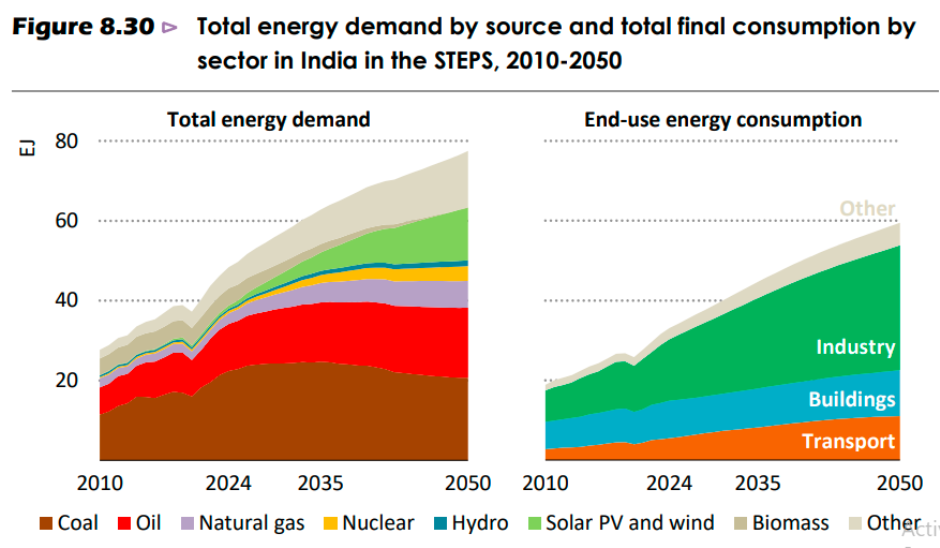India is the fastest-growing source of energy demand globally, according to the International Energy Agency’s World Energy Outlook 2025. With economic expansion, rapid urbanisation, and industrial growth driving a surge in consumption, India is transforming its energy system while working toward its ambitious net zero emissions target by 2070, IEA report indicated.
The following are ten key insights from the report outlining India’s evolving energy landscape, investments, and challenges.
1. India Leads Global Energy Demand Growth
India is the single largest contributor to energy demand growth worldwide to 2035, adding more than 15 exajoules (EJ) of demand — equal to the combined growth of China and Southeast Asia. The country is expected to lead oil demand growth, rank second in electricity and coal demand increases, and third in natural gas demand.
2. Rapid Economic Expansion Fuels Energy Needs
India’s economy is projected to grow at an average annual rate of 6.1 percent until 2035 — the fastest among major economies. Rising incomes, urbanisation, and industrialisation are pushing up demand for electricity, vehicles, air conditioning, and infrastructure. India’s GDP per capita in 2035 will be around 75 percent higher than today, supported by a sharp rise in energy consumption across sectors.
3. Universal Energy Access and Clean Cooking Remain Priorities
Despite major progress, nearly 20 percent of India’s population still relies partly on traditional biomass for cooking. The Pradhan Mantri Ujjwala Yojana continues to drive LPG access for low-income households. Achieving full access to modern energy remains central to India’s development and social inclusion goals.
4. Strong Policy Push for Clean Energy Transition
India aims to achieve net zero emissions by 2070 and has set ambitious interim goals — including a 50 percent share of non-fossil sources in its power mix by 2030. The country has already reached this milestone in 2025, five years ahead of schedule, reflecting strong policy support for renewables, biofuels, and carbon market mechanisms scheduled for rollout in 2026.
5. Solar and Wind Drive Clean Energy Investments
Solar PV and wind are the fastest-growing energy sources, accounting for nearly 20 percent of India’s total energy mix by 2050. Between 2015 and 2025, solar PV attracted over USD 113 billion in cumulative investment, surpassing total fossil fuel power investments. The investment ratio of fossil to non-fossil generation has shifted dramatically from 1:1 in 2015 to 1:4 in 2025.
6. Non-Fossil Sources Dominate Future Power Generation
By 2035, non-fossil sources are projected to make up 70 percent of installed capacity and contribute to over half of total power generation. Solar and wind generation will rise from 11 percent today to nearly 40 percent by 2035. Nuclear power capacity will triple, supported by India’s long-term goal to expand nuclear capacity to 100 GW by 2047.
7. Coal and Oil Still Play Key Roles
While renewables expand rapidly, coal and oil remain crucial to meeting India’s growing industrial and transport energy needs. Industry alone will account for more than half of total energy demand growth by 2050. Coal will continue to provide essential baseload and grid stability, although its share in generation gradually declines as renewables rise.
8. Grid Expansion and Energy Storage Gain Urgency
India’s shift to renewable power demands massive investment in grid infrastructure and storage. The report projects over 230 gigawatt-hours (GWh) of battery storage capacity additions by 2030, alongside a 35 percent expansion in transmission networks. More than 200,000 km of new transmission lines — including 60,000 km for renewables integration — will be added under the Green Energy Corridor initiative.
9. Reforms Strengthen Power Sector Financing
India’s distribution companies face financial constraints, with overdue payments of around USD 7 billion in 2025. Reforms such as payment security mechanisms, state-backed guarantees, and a dedicated security fund have been implemented to improve liquidity and investor confidence. These steps have doubled the share of foreign direct investment in the power sector to nearly 10 percent of total investment.
10. Emissions Peak by 2040, Then Decline
India’s carbon dioxide emissions are expected to peak around 2040, reaching about 3.4 gigatonnes by 2050. Cleaner power generation, improved efficiency, and rising non-fossil shares will reduce carbon intensity in electricity by nearly 45 percent by 2035, aligning India closer to global averages. The shift will also deliver air quality benefits, cutting emissions of fine particulates and sulphur dioxide.
Conclusion
The World Energy Outlook 2025 positions India as a key driver of global energy growth and transition. With early achievement of its clean energy targets, massive investments in renewables, and reforms to strengthen the power sector, India is charting a path toward sustainable growth. Balancing energy security, affordability, and decarbonisation will be central to ensuring India’s energy transformation supports both national development and global climate goals.
Baburajan Kizhakedath

